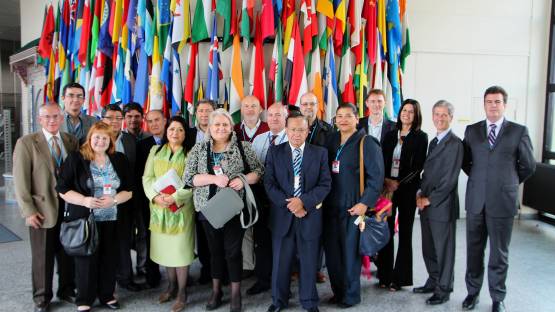A high-level technical meeting has taken place in Vienna, Austria, under the umbrella of the regional technical project RLA/7/018, 'Improving Knowledge of Groundwater Resources to Contribute to their Protection, Integrated Management and Governance'. From 25 to 29 August 2014, national experts from Argentina, Brazil, Ecuador, and Nicaragua joined their IAEA counterparts to explore the challenges and solutions that the project plans to address. During the meeting, participants formed smaller groups to evaluate the achievements of previous groundwater management projects, consider options for institutional collaboration, and identify existing gaps in hydrological data. The technical meeting concluded with the adoption of an agenda of work, which will guide the efforts of participating Member States until another coordination meeting is organized.
Although often hidden from plain view, groundwater is a vital resource and plays a key role in agriculture, industry and in the lives of ordinary people. Indeed, as supplies of surface water are strained by increasing evaporation, population growth and industrial demand, the importance of groundwater will only increase. Faced with the present and future demand for potable groundwater, several Member States in the Latin American region have worked with the IAEA to develop TC project RLA/7/018 in order to improve the understanding of these subterranean aquifers, in the hopes of better managing them for future generations.
RLA/7/018 was launched in early 2014 under the auspices of ARCAL, a cooperative agreement to promote nuclear science and technology in the region. Fourteen countries are participating in the regional project, namely: Argentina, Bolivia, Brazil, Chile, Colombia, Costa Rica, Cuba, Ecuador, Honduras, Mexico, Nicaragua, Paraguay, Uruguay and Venezuela.
The project focuses on two related factors: groundwater availability and quality. Particularly in semi-arid zones of the continent, access to groundwater in Latin America has been threatened by intense extraction practices. At the same time, water quality has been reduced due to mining and agricultural activities, as well as poor sanitation and waste disposal practices.
Fortunately, by deploying the appropriate nuclear techniques, IAEA experts and their national counterparts can gradually reverse these trends and reduce the risk of water insecurity. Stable isotopes of hydrogen and oxygen, for example, help to determine the origin of both water and foreign contaminants, such as nitrate, perchlorate, or other volatile organic compounds. Radioactive isotopes, on the other hand, are useful in identifying the age of groundwater sources, the frequency of recharge, or the time elapsed since water first entered the saturated zone.
In order to reliably build capacities in the use of these techniques, RLA/7/018 is implementing the iWAVE method, devised as part of the IAEA Water Availability Enhancement Project. The first steps involve identifying the national gaps in hydrological data and the infrastructure needed to fill those gaps. Next, IAEA experts will work to encourage collaboration and support from multilateral organizations in the region. Finally, through expert missions, workshops, and by facilitating equipment procurement, the project will support the development of skills at the national level necessary to carry out these isotopic measurements.
Water is of paramount importance in every country, and information and data is essential for its effective management. By leveraging the insight gleaned from both stable and radioactive isotopes, this regional technical cooperation project will arm Member States with the data necessary to determine the geological history, current condition, and future threats to groundwater resources in the region.
On the margins of the meeting, several participants were interviewed and asked to provide their thoughts on the project and its future implications for the Latin American region. You can hear their responses in the video under related resources.


